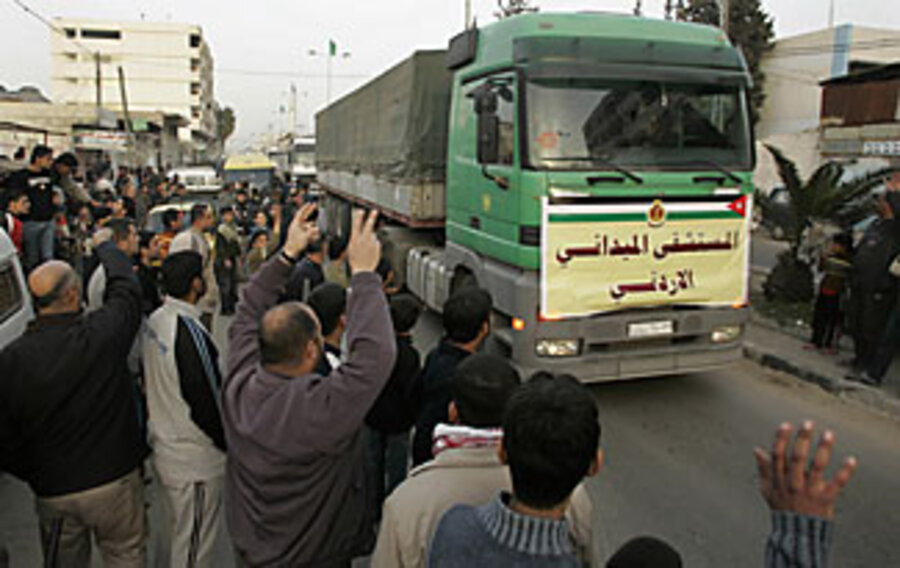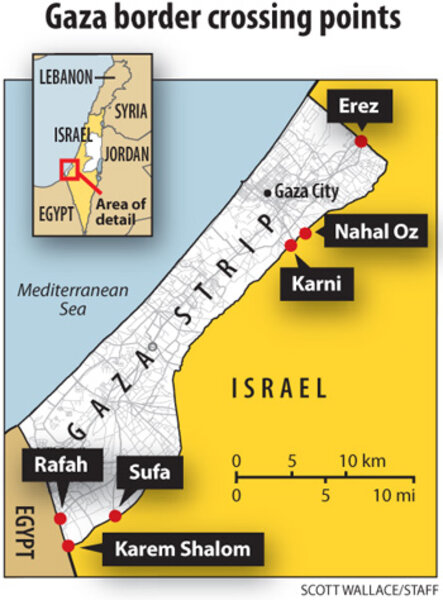Crux of Gaza cease-fire: border crossings
Loading...
| Gaza City, Gaza
After everything that Gazans lost in the past month of war, there is at least one thing many are hoping to gain – and which international aid providers say they must have: better access to the outside world.
Whether the cease-fire continues depends in large part, Hamas officials say, on whether Israel agrees to open the crossings it controls to Gaza. International agencies pushing to get more aid into the strip say there is still an insufficient flow of materials and a total absence of those that would help Gaza rebuild.
The demand to open the borders and end the virtual embargo on Gaza – levied since Hamas was elected in a parliamentary vote three years ago and more forcefully applied when it took over in a June 2007 coup – will be a key facet of revved-up cease-fire negotiations as Washington's new Middle East envoy, George Mitchell, arrives in Egypt on Tuesday.
With the world's eyes on the nightmarish remains of war, many voices are pointing to the unsustainability of turning Gaza into an isolated pariah state as a way to push Palestinians closer to peace with Israel.
"Unless the crossing points open, what we have are basics that are only keeping people alive. Miserable, but alive," says John Ging, the head of the United Nations Relief and Works Agency (UNRWA), the main United Nations agency dealing with aid to Palestinians.
"There's a lot of money out there, available to be used for help, but what needs to happen is to get the crossings open," says Mr. Ging. "There are thousands of tons of aid waiting to get in, boxes and boxes of it. They're in Egypt, they're in Jordan, and they're also in Israel. We have been sitting on $97 million budgeted to us for the past year-and-a-half, but we can't get the supplies in so we don't spend it."
Since the cease-fire a week ago Sunday, Israel has been gradually admitting more supplies, enabling the transfer of humanitarian goods and some aid workers through three of the five active crossings it controls: Kerem Shalom, Nahal Oz, and Erez. Since the beginning of the war, Israel says it has allowed 70,035 tons of humanitarian supplies into Gaza.
Unilateral cease-fires were holding by a thread after one Israeli soldier was killed and three wounded in a roadside bomb Tuesday; a Palestinian was also killed and one Gaza militant wounded following the bombing. Israel had said it would allow in food, medicine, and other essentials, but after the attack, Israel temporarily sealed its crossings.
Since the cease-fires were declared, Israel has ruled out fully opening crossings or letting in heavier materials – such as cement – for reconstruction.
"At the moment, the priority is given for the urgent stuff: food, medical supplies, and other basics," says Maj. Peter Lerner, an Israeli military spokesman. "But we are not willing to rebuild Hamas's bunkers and underground tunnels, and we're not willing to help give them materials to transform into rockets to fire at us."
Israel is waiting for a reconstruction plan from the international community, he says, which is expected to be presented in a few days. And it will insist it be followed. "Each piece of metal and piping will reach a specific destination and not just be sold on the open market," Major Lerner adds. "We have intentions to help them rebuild, but not to supply things for the Hamas terrorist infrastructure."
Part of the Hamas government's requirements for a lasting cease-fire is that the crossings be open on a steady basis. "If they don't open the borders, the cease-fire is fragile and it will explode," warns Mohammad Awwad, the politburo chief of the Hamas government in Gaza. Most complicated will be reaching a formula to satisfy this demand, given Israel's need to protect its citizens, 1 in 8 of whom are in rocket range from Gaza.
Following its disengagement from Gaza in August 2005, many Israelis adopted the stance that the Gaza was "no longer our problem." But with Israel controlling the access by land and sea, most Palestinians view the territory as occupied. Following Hamas's June 2007 coup, Israel declared it a "hostile territory."
The problem, however, is that in that since the 1967 war, in which Israel seized this coastal territory from Egypt – much of it filled with Palestinian refugees from the war for Israel's establishment 1948 – Gaza was increasingly linked to Israel's economy. Until the second intifada in 2000, about 130,000 Gazans worked daily in Israel. The remnants of this connection remain – from Gaza's use of the Israeli shekel as its currency to the phones that are reached by calling Israel's '08' country code.
Egypt maintains only the Rafah Crossing, which is primarily a pedestrian terminal and not equipped to handle heavy commercial traffic. Egyptian officials have temporarily loosened the tight restrictions on who and what they allow to pass through Rafah, but they remain either unwilling or unable to provide for the needs of Gazans, in part because Egypt does not want to assume responsibility for the territory.
Mr. Mitchell arrives tasked with solving the crossings challenge. So far, Israel has proposed a partial easing of traffic at the crossings along with a cease-fire that would last a year and a half. Hamas rejects that proposal. It wants Israel to fully lift the blockade.
Nonetheless, Mukhaimar Abusada, a Gaza political scientist, says Hamas desperately needs to show it gained something – namely access to the outside world – in the war with Israel. "You can't keep claiming victory when what we see is catastrophe."






